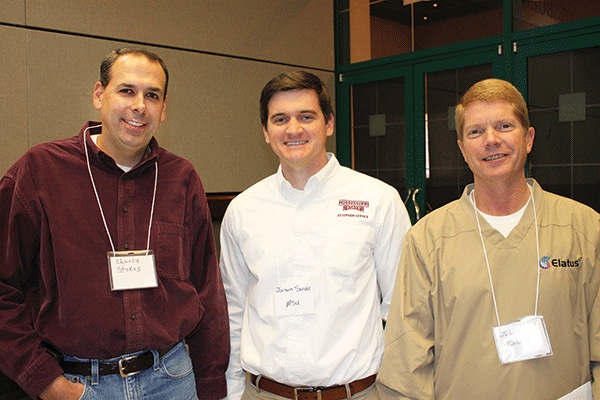
Soil temperature is important when planting peanuts
A lot of Mississippi growers planted peanuts last year when soil temperatures were in the 50-65 degree range, "and they just sat there," says Jason Sarver, Mississippi State University Extension peanut specialist, who spoke at the annual meeting of the Mississippi Peanut Growers Association. In many cases cool rains followed, he says, and "some seed were in the ground as long as three weeks before they started to germinate — and some took upwards of a month to emerge.”

Optimum soil temperatures at planting can make a significant difference in emergence of peanuts, says Jason Sarver, who says lasts year’s cool, wet spring generated a lot of calls from growers asking, “Why aren’t my peanuts coming up?”
A lot of peanuts went in the ground when soil temperatures were in the 50-65 degree range, he told members of the Mississippi Peanut Growers Association at their annual meeting, and in many cases cool rains followed.
Stay current on what’s happening in Mid-South agriculture: Subscribe to Delta Farm Press Daily.
“The peanuts just sat there for a long time,” he says. “Some seed were in the ground as long as three weeks before they started to germinate and some took upwards of a month to emerge from the ground.”
Sarver, who is assistant Extension and research professor of plant and soil sciences at Mississippi State University and the state’s peanut specialist, says work done in Georgia has shown the importance of soil temperature for timely, uniform germination.
The studies, with Georgia 06G variety, showed that seed planted at 65 degrees soil temperature had only about 70 percent germination after one week. At 70 degrees, germination was about 90 percent, and at 74 degrees, about 95 percent.
“If you can possibly do so, wait for soil temperatures in the 68-70 degree range to put seed in the ground,” he says.
Despite the slow, uneven start last year, and quite a bit of seed rot, “Most growers had good stands,” Sarver says. “A lot of the fields that were wet and/or washed out early in the season ended up doing well as soils warmed up and dried out.”
Use proper inoculant
There were instances, he says, where some fields weren’t properly inoculated, resulting in problems in plant height and width, differences in coloration, lack of nitrogen, and season-long weed emergence. Many of these problems stemmed from situations where growers used inoculant additives rather than the inoculant bacteria or soybean inoculant — the latter “a different species,” Sarver says.

CLICK HERE to see photos from the 2015 Mississippi Peanut Growers Association annual meeting.
“Be sure to use a peanut-specific inoculant. This likely will be an even bigger issue as we expand acreage, and it’s something we need to be aware of, particularly on new ground. This is probably going to be something we’ll see more of in the future as we see buildups of soil disease inoculum.”
Mississippi had about 31,000 acres of peanuts last year, according to the USDA final estimate, he says. “That was somewhat lower than our original estimate of 38,000 acres. The National Agricultural Statistics Service’s published yield estimate through the summer was 3,500 pounds. All the while, I was seeing a good-looking crop that I was estimating at 4,100 to 4,200 pounds.
“The NASS final estimate was about 4,000 pounds. By actual graded tons, we were a bit better than that, around 4,100 pounds — close to Georgia’s and Florida’s average, and quite a bit better than Alabama, which has fewer irrigated acres, as a percentage, than other states.
“As our growers have shown in recent years, we can do an excellent job of growing peanuts in Mississippi. We still have some inherent production advantages, particularly with disease control. But, that won’t linger forever, and we’ll constantly have to modify and adapt our approach in coming years in order to deal with problems that arise.”
About the Author(s)
You May Also Like



